Tag: Sara Conway ’21
FORESHADOW: A Serial YA Anthology of Short Stories, Published Digitally
by The Cowl Editor on December 6, 2018
Arts & Entertainment
by: Sara Conway ’21 A&E Staff
Foreshadow: to indicate a future event.
Emily X.R. Pan and Nova Ren Suma, both New York Times bestselling authors, used this definition as inspiration to create their own online Young Adult (YA) literary magazine.
Pan and Suma’s first connection occurred through Twitter, which possesses an active writing and bookish community. In an interview with School Library Journal, Suma states that the two authors were initially brought together because of writing; she was given a chance to read Pan’s New York Times bestselling novel, The Astonishing Color of After, early even before Pan signed with an agent.
On a train ride to Washington, D.C., the authors discovered that they both dreamed of creating an online literary magazine that centered around YA stories. It was here that the idea for FORESHADOW was born.
FORESHADOW stands out among other anthologies and online literary magazines as it will have a finite publishing period (hence “serial anthology”). Pan and Suma decided to publish their anthology for one year with the publication of issues beginning in January 2019 and ending in December 2019.
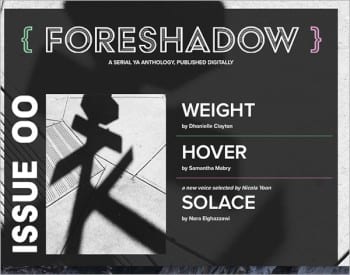
Each issue of the anthology will feature three YA short stories by well-known authors in YA literature, as well as a piece by a “New Voice.” This title is reserved for a writer who is emerging in the industry.
FORESHADOW demonstrates a “commitment to showcasing underrepresented voices, boosting emerging writers, and highlighting the beauty and power of YA fiction,” as the anthology’s main purpose. The team behind FORESHADOW, along with the anthology, hopes to “contribute to the changing landscape of young adult publishing to become more inclusive and diverse.” The creators are particularly dedicated to highlighting stories told by marginalized and underrepresented voices.
When asked about the significance of the title, “foreshadow,” Pan and Suma answer that they “hope that the new writers” discovered in the anthology “will be authors whose books [readers will] covet tomorrow.”
This theme of foreshadowing also manifests through the one word titles of the published stories. The anthology asks authors to choose their own title, musing over the question: If you could distill your story into one word, what would it be? Foreshadowing is all about leaving clues; the title of the story indicates to readers what can be discovered or expected when they read on.
Doing some foreshadowing of their own, Pan and Suma released Issue 00 this past summer in order to give readers a taste of what is to come. Issue 00 features stories by Dhonielle Clayton, author of the New York Times bestseller The Belles, Samantha Mabry, author of All the Wind in the World, which is longlisted for the National Book Award, and the first “New Voice” of FORESHADOW, selected by Nicola Yoon. The #1 New York Times bestselling author writes of the “New Voice” piece: “In the space of just a few pages, ‘Solace’ takes us on the beautiful, hopeful journey of a young woman trying to find her way back to herself. It’s a lovely story of new love, recovery, and a magical garden.”
The subsequent issues of FORESHADOW will follow the example that Issue 00 provides: an established author like Nicola Yoon will “select, introduce, and hopefully elevate new writers.”
Most of all, Pan, Suma, and the rest of the FORESHADOW team want the stories in their anthology to be read; thus, they created the issues so that the pieces can be easily printed or read offline and accessible to everyone.
Through this accessibility, FORESHADOW provides emerging writers the chance to become known to the world. Suma states that both she and Pan had their “first breaks publishing stories in literary journals.” She contemplates further that FORESHADOW could be the platform for other writers to jumpstart their own writing careers.
“You Will Be Found:” Dear Evan Hansen: Broadway’s Hit Show Continues to Inspire Through Its Novel Form
by The Cowl Editor on November 29, 2018
Arts & Entertainment
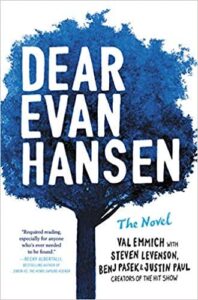
by Sara Conway ’21
A&E Staff
Today is a good day, and here’s why…
Ever since premiering on Broadway in late 2016, Dear Evan Hansen has remained a phenomenon across the globe, winning six Tony Awards in 2017, including Best Musical.
Evan Hansen is a high school senior who struggles with severe social anxiety and becomes intimately connected to the death of a classmate named Connor, after Evan’s therapy letter is found on the student and assumed to be the boy’s suicide note. He lies about his relationship with the classmate, entangling himself in a web of half-truths and made up stories. Evan finally gets a chance to belong, but at what cost?
Creators Steven Levenson, the playwright, and Benj Pasek and Justin Paul, the songwriters, collaborated with writer, singer-songwriter, and actor Val Emmich to bring the novel to life.
Published by Poppy, an imprint of Little, Brown and Company, Dear Evan Hansen: The Novel is a standalone that seeks to bring the story of Evan Hansen to people who may be unable to see the show on Broadway.
In addition, the novel shares what had to be cut in the process of developing the musical. Levenson states in an interview with Publishers Weekly that the creators had “so much stuff that ended up on the cutting room floor” and “so many ideas about who these people were and where they had come from.”
Dear Evan Hansen: The Novel allows readers to understand the characters from the show on a deeper level, something that is lost in the musical. Readers see more of Connor, his personality, and his hurt as well as his side of the story. Also, since the novel is told from Evan’s perspective, the audience maintains a direct connection with his perspective and his thoughts. The musical, in contrast, attempts to show the sides of most of the characters through the different songs.
Familiar scenes are included in the novel that many readers will recognize, such as the “You Will Be Found” sequence. Others lead to a new level of understanding of the relationship between Evan and his father in Colorado, as his mother and father divorced when he was young.
As with the musical, the novel tackles topics that need to be out in the open and talked about such as bullying, mental illness, and suicide. Both contemplate the potentially devastating impact of not checking in on loved ones. There are many people who are hurting on a level that is deeper than one’s initial understanding.
The novel and the Broadway show take care to not conclude with a “happily ever after” ending. As Evan discovers, there are serious ramifications for lying even with good intentions. But there is good and hope that emerges from tragedy and pain as well, even if it is in ways that are unexpected.
Dear Evan Hansen, in short, is a story of hope, of knowing that you are not alone, and of realizing that you will be found.
Rick Riordan Presents Joins Disney-Hyperion Publishing: Author Encourages Diverse Mythological Stories Through His New Imprint
by Kerry Torpey on November 15, 2018
Arts & Entertainment
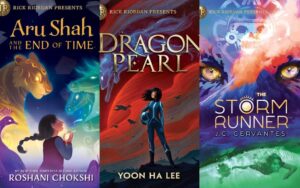
by Sara Conway ’21
A&E Staff
The story of Percy Jackson began as a bedtime story for one of Rick Riordan’s sons, Haley. When Riordan ran out of traditional Greek myths to tell, he created Percy Jackson who went on a “quest to recover Zeus’ lightning bolt in modern day America.”
A demigod with ADHD and dyslexia, Percy Jackson reflected the difficulties that Riordan’s own son was struggling with. At the time Riordan was writing, Haley was in the process of testing for mental dysfunction since he was “having trouble reading and some trouble focusing in the classroom.”
In an interview posted on his website, Riordan acknowledges that individuals with ADHD/dyslexia are “creative, ‘outside-the-box’ thinkers” who see and solve problems in a different way than most do, but they are “sometimes written off as lazy, unmotivated, rude, or even stupid.”
The Lightning Thief and the creation of Percy Jackson was Riordan’s “way of honoring the potential” of the kids who struggle with ADHD and dyslexia like his son. Through Percy Jackson and his other mythology-based series, including The Heroes of Olympus, The Kane Chronicles, and the Magnus Chase and the Gods of Asgard series, Riordan stresses that, “It’s not a bad thing to be different.”
Riordan’s positive message emerges in his new imprint, launched by Disney-Hyperion, Rick Riordan Presents, which is “devoted to mythology-based books for middle grade readers,” according to Publisher’s Weekly.
The creation of Rick Riordan Presents responds to the numerous questions Riordan receives from his fans about writing books about other mythologies. Rick Riordan Presents aims to “publish great middle grade authors from underrepresented cultures and backgrounds.” Riordan as an author has stepped back to let these writers “tell their own stories inspired by mythology and folklore of their own heritage.”
The first book under the Rick Riordan Presents imprint was written by Roshani Chokshi, a young adult author well known for her duology, The Star-Touched Queen. Chokshi’s book, Aru Shah and the End of Time, focusing on Hindu mythology, was published on March 27, 2018. Kirkus (a starred review) applauded Chokshi for “spin[ning] a fantastical narrative that seamlessly intertwines Hindu cosmology and folklore, feminism, and witty dialogue for an uproarious novel for young readers.”
The imprint recently released its second book, The Storm Runner, by Jennifer Cervantes on September 18, 2018, a story about a 13-year-old boy with physical disabilities and a connection to the Mayan gods. The Storm Runner also received starred reviews from Booklist and School Library Journal who declared the book a “page-turning and well-written trip into the world of Mayan mythology.”
Yoon Ha Lee’s book, Dragon Pearl, is slated to be published in January 15, 2019. Pitched as sci-fi meets Korean mythology, the space opera book already possesses two starred reviews. Kirkus Reviews states how Dragon Pearl is a “brilliant example of how different cultures can have unique but accessible cosmology and universal appeal.”
Not only does Dragon Pearl center around Korean mythology, but Lee also features a nonbinary character, emphasizing Riordan’s goal of creating books that will allow young readers to see themselves in the stories that they read.
Rick Riordan Presents has sequels for the two released books set to be released between 2019 and 2021, as Aru Shah is a four-book series. Seven other books focusing on mythologies ranging from Cuban to African are expected to be published, starting in March 2019 and extending to May 2021.
PC’s Dr. Bing Huang on Asian Art Through VR Games
by The Cowl Editor on November 8, 2018
Arts & Entertainment
by: Sara Conway ’21 A&E Staff

Dr. Bing Huang, a professor of art & art history, recently sat down with The Cowl to discuss her new course, coming up this spring, entitled ‘Asian Art through VR Games.’
Sara Conway (SC): What inspired you to teach a class based on Virtual Reality?
Professor Bing Huang (BH): It’s virtual reality, it’s a technical achievement, but mainly it’s fun! You will find the future where people are having the most fun. I want to bring the most cutting-edge visual technology to Providence College students. The experience of VR is bringing us closer than ever to science fiction. Not everyone has experienced VR, and as yet very few colleges offer VR courses. I got my first VR Oculus developer headset four years ago even before it was commercialized. MIT was one of the first places to teach this technology and that was where I learned it with Professor Takehiko Nagakura. I’ve always been fascinated by digital innovation and transformation.
I am an art historian and I feel that art truly revolves around the technology or media of its time. If you think about the art of our day, museums and galleries are important and the first thing that comes to mind, but I do not confine contemporary art to museums or other art institutions. I think that our contemporary art involves gaming, movies, and social media (such as Instagram and Facebook). These are the biggest warehouses of images and should be considered the contemporary art of our age. Everyone can be an artist and self-made internet celebrity, and create great content for our modern image consumption.
VR is one step forward. It is the art of the future. On the surface, this outer world is available to us only through sensory streams, but VR affects our cognitive consciousness on a deeper level. In this course, the students can walk into new dimensions and experience worlds without limits. It raises the question: are visual consciousness and bodily self-consciousness related to each other? If all of our senses were to be replaced with virtual ones, would reality be replaced too? Why play a game when you can live it?
What this class wants to reveal to the student is that they are not only playing games but also creating games. I remember, last year, one of my students whose name was Thomas Begley ’18, after learning how to paint bamboo in Chinese painting, created a Chinese bamboo grove in virtual reality. Another student in the class put on the goggles for the first time and was teleported to the bamboo grove that Thomas had created. It was truly a full body, wholly immersive experience.
SC: In what ways does VR enhance the learning experience for students who have had little exposure to Asian art?
BH: Historically, we consider the best way to experience art and architecture is to stand in front of the original. For one thing, VR is helpful when the original is inaccessible. Moreover, experience through VR can be redesigned and made more breathtaking and educational than would be standing in front of the original. That is why I created the Asian Art through VR Games course. This course aims to create a new experience based on VR games to facilitate the understanding of Asian Art.
I’ve already created several VR games while at MIT. For example, there’s Ancient Chinese Architecture, Buddhist Caves, Emperors’ Tombs and Japanese Temple. Students can play games which will allow them to feel like they are in ancient Japan and China. The experience is very real, and the closest thing to actually being in Japan and China. More than that, you’re inside a time capsule of ancient Asia, with your entire mind and body immersed in virtual worlds where reality and imagination mix in breathtaking, hyper-realistic experiences. One second, you’re standing in a PC classroom and the next you’re in a Japanese garden. You’d have to experience it to understand it fully.
SC: What do you think is going to be your favorite aspect about teaching this class?
BH: What’s exciting for me about teaching in general and teaching this course in particular is being able to interact with the students. The greatest thing about being a professor is the students. I truly treasure the time that I spend with my students. They are curious and produce an unceasing stream of innovation. I look forward to seeing what my students are going to create on this course. I will be thrilled to fly drones and make VR movies with my students. With more than half of American adults and four-in-five young adults now estimated to play digital games on a regular basis, this course provides a strong humanities education backed by virtual reality technology. Knowing how to create VR content will place these students in a highly advantageous position with regard to the job market upon graduation.
The Hate U Give: Angie Thomas’ Eye-Opening Novel Hits the Big Screen
by The Cowl Editor on November 1, 2018
Arts & Entertainment
by: Sara Conway ’21 A&E Staff
When Angie Thomas’ debut novel The Hate U Give (THUG) was released on February 28, 2017, the book raced to the top of the New York Times bestseller list. In fact, THUG took over the number one spot within its first week out in the public. Since the novel’s original publication date, it has remained on the bestseller list for 86 weeks.
The film adaptation of The Hate U Give follows 16-year-old Starr Carter (Amandla Stenberg) who witnesses the fatal shooting of her childhood friend, Khalil Harris (Algee Smith), by a white police officer. The story, in both the book and the movie, takes off as Starr struggles between speaking up or continuing on with her somewhat normal life.
THUG was optioned for a film rendition in late 2015 by Fox 2000 with George Tillman, Jr. as the director, Audrey Wells as the screenwriter, and Stenberg set to star. The movie was officially released on October 19, 2018 featuring well-known names, such as Russell Hornsby, Common, Regina Hall, Issa Rae, Sabrina Carpenter, KJ Apa, and Anthony Mackie.
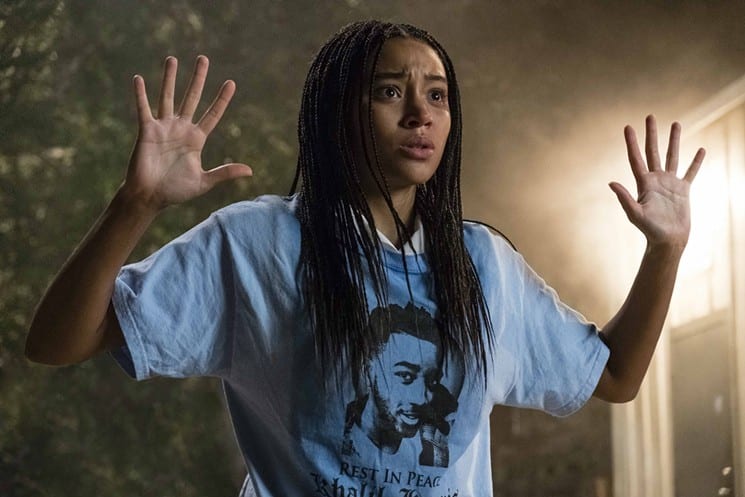
The movie opens with Starr’s father (Hornsby) giving his family “the talk,” only it is about how not to get shot by a police officer. Nine-year-old Starr mimics her father by putting her palms flat on the dining room table, her fingers stretched out. This scene foreshadows the traumatic events to come later.
THUG shows the different sides of the police brutality issue in America. The movie highlights Starr’s perspective as the sole eyewitness to her friend being shot and killed—although he was not armed; he was holding a hairbrush. It also includes a glimpse into the cop’s panicked reaction to killing Khalil. Angie Thomas adds another layer of complexity to the story by intentionally making Starr’s uncle, Carlos (Common), a police officer. In fact, he is in the same force as the cop who shot Khalil.
On top of everything else, Starr faces casual racism from a friend in addition to struggling to fit in at her school. Starr and her two brothers attend a private school in a predominantly white and wealthy suburb, a stark contrast to her home, Garden Heights, a low-income, black neighborhood. At school, Starr becomes another version of herself, beginning with code switching; she mentions that slang makes her classmates look cool while it makes her “hood.”
The various exchanges between Starr and her friend demonstrate the power of the news and how its influence dictates the way a story is represented to those distant from an event. The Hate U Give makes readers and moviegoers see from a different perspective. The book and the movie force the audiences to feel even if it is just a sliver of what is actually experienced in reality.
Heavily influenced by famous rapper Tupac and the Black Lives Matter movement, The Hate U Give presents to readers and moviegoers a profoundly human story. The title was inspired by Tupac’s T.H.U.G. L.I.F.E tattoo: “The Hate U Give Little Infants F**ks Everybody.”
Thomas weighs in on its meaning through an interview with Cosmopolitan as she says, “When these unarmed black people lose their lives, the hate they’ve been given screws us all. We see it in the form of anger and we see it in the form of riots.” The Hate U Give tells a story of race, a story of loss and trauma, and a story of finding one’s voice; however, it is ultimately a story of hope.
On Writing The Poppy War: An Interview with R.F. Kuang
by The Cowl Editor on October 25, 2018
Arts & Entertainment
Discussion on Inspiration and Research for Recent Novel
by: Sara Conway ’21 A&E Staff
History repeats itself. R.F. Kuang and her debut novel, The Poppy War alerts a more American- and European-centric audience to the little known histories of modern China and Japan. Through The Poppy War, Kuang writes of a past that should not be forgotten.
Kuang has spoken extensively on the inspiration for The Poppy War. The central focus of the novel is the 1937 Rape of Nanjing, which is sometimes referred to as the “forgotten Holocaust.” Meanwhile, the rest of the 544-page book draws on other events of 20th century China, with the plot being set in a fantastical kingdom heavily influenced by ancient China.
As a historian, Kuang mentioned how The Poppy War resulted from her thorough studies concerning Chinese history. She has a degree in international history from Georgetown University and is currently pursuing a masters in modern Chinese history at the University of Cambridge. She plans on obtaining a second masters in Japanese history as she had said that one cannot “understand modern China without understanding Japan.” In addition, Kuang hopes to acquire a doctorate in Chinese studies in the United States.
I recently got the opportunity to ask Kuang a few questions about the writing of The Poppy War in the wake of publishing a review on her novel in The Cowl two months ago.
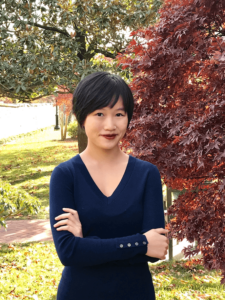
Sara Conway (SC): Which character came to you first? Whose voice was the strongest when you were writing?
Rebecca Kuang (RK): Nezha actually came before Rin because I thought that he’d be the main POV character, but I quickly discovered that Rin’s personality just overwhelms every other character’s. Besides that, Jiang was my favorite and by far the easiest to write. Weirdly, he makes more sense than any of the other characters do.
SC: For the readers who can stomach this intense novel, what do you hope they take away from The Poppy War?
RK: History moves in circles, and don’t do drugs.
SC: What was it like researching for this novel?
RK: Pretty much the same as if I were researching an academic paper, except that I didn’t have to cite things and I could make things up if I wanted to. I started with Iris Chang’s The Rape of Nanking, which forms a lot of the thematic and moral core of the story. I also read works by Frank Dikotter, Peter Harmsen, Hans van de Ven, and others on the history of China during World War II. This was a fun project because I got to fuse influences from different historical time periods–so for most worldbuilding consultation, for instance, I drew on sources about the Song Dynasty, even though I was telling a 20th century story.
SC: Was there anything in your research that really caught you off-guard? Did you have a scene or piece of information you really wanted to put into the novel but eventually had to scrap it?
RK: A lot of the horrors of Unit 731 kept me up at night. I had a lot of scenes written where I delved deeper into what was going on at that research facility, but ended up cutting it for pacing reasons. That was probably for the best; those chapters are difficult enough to read as is.
The story continues in the second book of Kuang’s trilogy, The Dragon Republic, coming June 2019.
BTS: Boyband Takes the World by Storm
by The Cowl Editor on October 18, 2018
Arts & Entertainment
Bringing K-Pop to Mainstream America
by: Sara Conway ’21 A&E Staff
Energetic chants filled the Citi Field stadium on the night of Oct. 6: “Kim Namjoon! Kim Seokjin! Min Yoongi! Jung Hoseok! Park Jimin! Kim Taehyung! Jeon Jungkook!” These are the names of the seven members of the hit K-Pop group, BTS.
The boy band was formed by Big Hit Entertainment, an entertainment company based in South Korea, starting with Kim Namjoon (RM), the leader of the group. BTS consists of three rappers: Suga, J-Hope, and RM, as well as four vocalists: Jungkook, the main vocalist, Jimin, V, and Jin.
The seven released their debut album in 2013, becoming popular within the K-Pop genre for their dance choreography and have since attracted a dedicated fanbase, called ARMY.
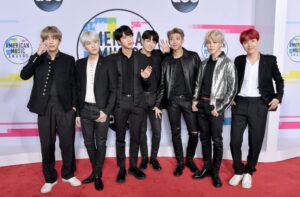
It was in 2015, however, that BTS broke into the Billboard 200 with their album, The Most Beautiful Moment in Life, Pt. 2. Their last three albums of the Love Yourself series all made it into the top 10 of the Billboard charts. Their two 2018 albums, Love Yourself: Tear, released in May, and Love Yourself: Answer, released in August, both peaked at number one.
BTS kicked off their sold out Love Yourself World Tour in Seoul before coming to the United States. In New York, BTS was the first K-pop group to perform a stadium show at the historic Citi Field which holds over 40,000 seats.
The group recently started the European leg of their tour, stopping first in London. The first leg of the tour concludes with BTS in Paris, giving the group a well-deserved break from the nonstop performances, as the Asian segment of the world tour picks up again in mid-November.
The success of BTS is not only seen in the magnitude of its tour schedule but also through the notable lauds they received in recent years. Through the Billboard Music Award for Top Social Artist, a fan-voted category, ARMY demonstrated the extent of its power, ending the six-year streak of Justin Bieber. BTS won the award in 2017, when they performed, and in 2018.
During the 2017 American Music Awards, the group performed their hit song, “DNA,” marking their major break into American households. About a week ago, while in London, BTS won the Favorite Social Artist award for the 2018 AMAs. As their success continues, BTS is quickly becoming a household name and many predict that they will not be slowing down anytime soon.
A Thousand Beginnings and Endings: A Mythological Anthology
by The Cowl Editor on October 4, 2018
Arts & Entertainment
by: Sara Conway ’21 A&E Staff
Some stories start with, “Once upon a time,” others reveal the mysteries of the gods and their relationships with the human world. However, all stories tell something about their culture and their people.
This is no less true for the young adult anthology, A Thousand Beginnings & Endings, edited by Ellen Oh and Elsie Chapman and published this past June. One thing that differentiates this collection from most is that it brings together tales from East and South Asian cultures which were written by authors from those backgrounds.
As the co-founder, president, and CEO of We Need Diverse Books (WNDB), a nonprofit organization dedicated to advocate for diversity in children’s literature, Oh is a passionate voice for these kinds of diverse stories.
Also part of the WNDB team, Chapman is a young adult and middle school author who supports the WNDB mission and its vision: “Putting more books featuring diverse characters into the hands of children” so that one day the world becomes one where “all children can see themselves in the pages of a book.”
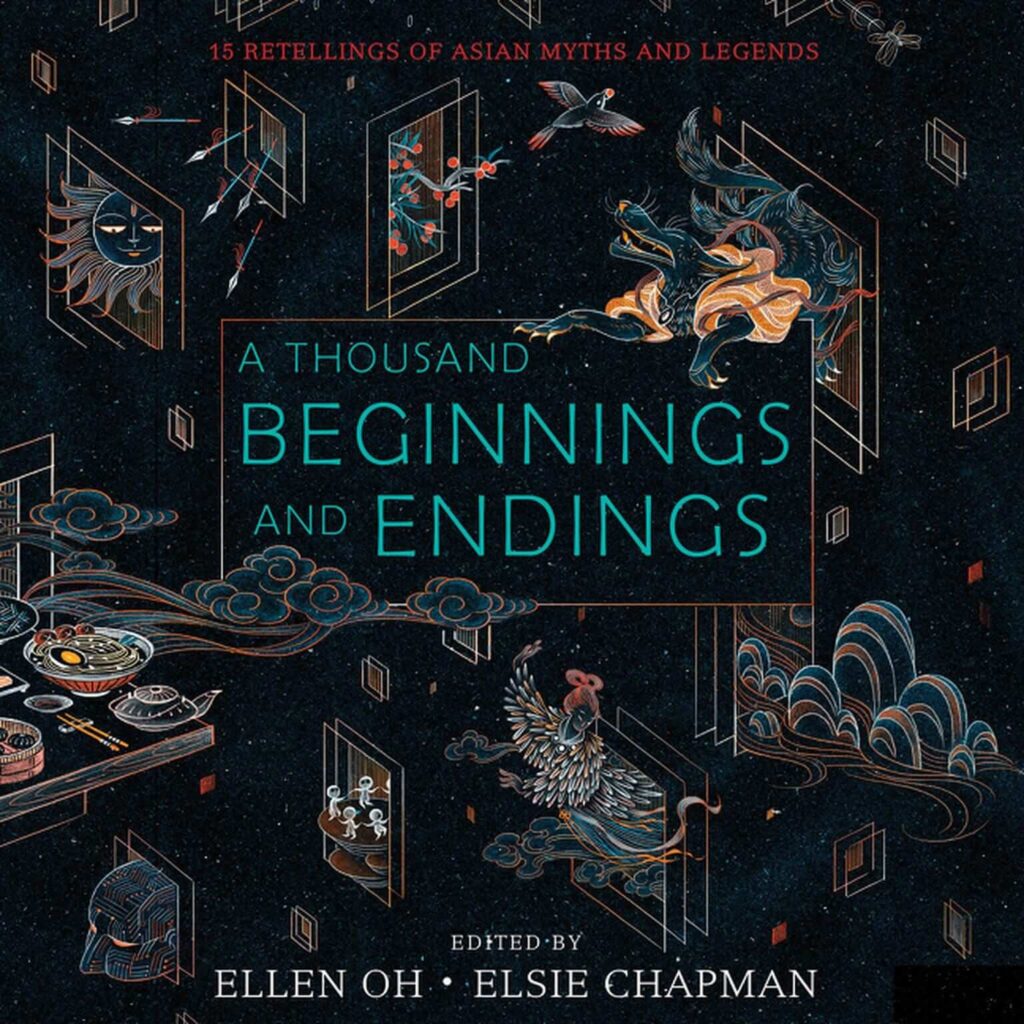
In their opening note, the editors tell readers how they noticed the lack of Asian mythological stories told by Asian authors. They explain that the ones that they did find were often “retold by non-Asian writers that never felt quite right. They were always missing something.” In addition, the editors “longed for nuance and subtlety and layers, the embedded truths about culture that—more often than not—can only come from within.” A Thousand Beginnings and Endings is their answer to this deficit.
Oh and Chapman recruited both well-known authors and those who were a little more under the radar in the book community to write a short story for the collection. Big names include Roshani Chokshi, the writer behind The Star Touched Queen and its companion, A Crown of Wishes, Reneé Ahdieh, the author of Alex & Eliza, and Cindy Pon of the sci-fi/fantasy novel, Want.
Reading this anthology exposes readers to stories that they might not be aware of. They hold just as much magic as the mythological narratives from Western cultures, such as those from the Greeks and the Romans. A Thousand Beginnings and Endings also features notes from the authors after their stories, allowing them to explain more about the original myth or legend as well as their reasons for choosing the tales that they did.
Each author approached their retellings through different lenses: some stuck with a more traditional story that wove many different versions into one, while others branched out and spun a contemporary or science fiction story from an ancient myth. Certain re-imaginings highlighted the strength of women; others placed an emphasis on family relationships.
A story from the anthology that resonated most strongly was the retelling of “Olivia’s Table” by Alyssa Wong. Wong weaves a narrative around the Hungry Ghost Festival, which occurs in the late summer during the seventh month of the lunar calendar. By placing the story in Arizona, Wong gives a nod to the Chinese immigrants who settled in the American West. In her retelling, Wong stresses the importance of ancestors in Chinese tradition and the significance of food in Chinese culture.
The authors featured in the collection contemplate the notion that most humans are not strictly good or evil. In their retellings, they uncover how everyone has strengths and weaknesses in their character. All of the stories in A Thousand Beginnings and Endings emphasize the nuances of humanity that make it so complex while transferring these narratives into another context.
Kid Lit Authors Say, “No Kids in Cages”
by Kerry Torpey on September 20, 2018
Arts & Entertainment

by Sara Conway ’21
A&E Staff
The children’s literature community spoke up and took action when needed most. This past June when the Trump administration declared a “Zero Tolerance” immigration policy that literally tore families apart. About 2,000 children were separated from their parents and detained at the U.S./Mexico border, some being kept in cages surrounded by metal fencing. Children’s literature, or “Kid Lit,” authors responded immediately to the policy, sparking the creation of “Kid Lit Says No Kids in Cages.”
Their mission statement details, “We believe that innocent children should not be separated from their parents. We believe the “Zero Tolerance” directive issued by Attorney General Jeff Sessions is cruel, immoral, and outrageous. We believe the Department of Justice is engaging in practices that should be restricted to the pages of dystopian novels.”
Twenty powerhouse authors in children’s literature signed the initial statement, including Ransom Riggs, Tahereh Mafi, Marie Lu, Jenny Han, Adam Silvera, and Nicola Yoon. Other familiar names signed the mission statement following the announcement of the campaign such as Rick Riordan, Victoria (V.E.) Schwab, Tomi Adeyemi, Becky Albertalli, Leigh Bardugo, Roshani Chokshi, and Angie Thomas.
A declaration closes the passionate mission statement in bold, red letters: “We demand and expect better, and call on our readers to do the same.” Featured in the Los Angeles Times and Publishers Weekly, the articles highlighted the bold campaign of the Kid Lit community and their power as a rallying force.
Not only does the campaign urge the audience to sign the statement, it also encourages readers to help in any way that they can. “Kid Lit Says No Kids in Cages” calls for donations that are then split between six organizations: Refugee and Immigrant Center for Education and Legal Services (RAICES), The Florence Project, the American Civil Liberties Union (ACLU), Women’s Refugee Commission, Kids in Need of Defense (KIND), and Al Otro Lado.
The campaign initially set a goal of $42,000, which was met in under 24 hours. Two weeks later, the donations amounted to over $200,000 with 5,000 signatures on the statement. Their next goal was to reach $275,000. Now, over $240,000 has been raised.
Kid Lit also compiled resources including posters, graphics, and other information to enable their readers to spread the word and raise their voices against the separation of families. The Kid Lit community also urges readers to call their representatives and to register to vote, citing it as the “best way to hold your government accountable.”
To All the Boys I’ve Loved Before: More Than Just a Rom-Com
by The Cowl Editor on September 13, 2018
Arts & Entertainment
by: Sara Conway ’21 A&E Staff

Since the release of the Netflix film To All the Boys I’ve Loved Before, all anyone is talking about is Lara Jean Song Covey and Peter Kavinsky (but mostly Peter Kavinsky). Lara Jean, however, is a more important character than one might initially believe.
Based on the bestselling book by Jenny Han, To All the Boys I’ve Loved Before tells the story of Lara Jean Song Covey, who has written a series of secret love letters that one day are suddenly sent out. She then struggles to navigate high school and love while avoiding her main crush and simultaneously falling in love with an old one.
Lara Jean is Korean American; all the producers but one wanted to make her white. Han wrote in her op-ed that a producer once said to her, “as long as the actress captures the spirit of the character, age and race don’t matter.” Many would disagree.
Han shot back, “Well, her spirit is Asian American.” She had earlier made clear that her heroine was Asian American; there was no negotiation about that fact.
Asian Americans do not get much representation in media. There has been more recognition of Asian authors who write novels featuring Asian American leads, but this representation is still miniscule compared to the stories revolving around white heroes and heroines.
According to 2016 data, which focused on writers and authors in the United States, Asian writers only made up 4.5 percent compared to the 86 percent of white writers.
It may not seem like a big deal, but to see a main character that looks like you is important. In this case, where the main actress or character is Asian, and is front and center, means viewers may realize how little Asian representation there is in popular media. This fact can make someone feel marginalized and alone.
In her op-ed, Han wrote about her journey to become an author. According to her article, Han started writing when she was young. Yet, it did not occur to her that she could “grow up to be a writer.” Kids are always asked what they want to be when they are older; imagine not believing your dream could be a reality because of your skin color.
Han sold her first novel in 2005, determined to put an author photo on the back of the book, regardless of the fact that many did not do that. She wrote that she “wanted Asian girls to see my face.” Adding to this statement, Han followed up by writing that she, “wanted them to see what is possible.”
To All the Boys I’ve Loved Before tells a new story and creates new possibilities: possibilities that may have seemed impossible at another point in time. A romantic comedy that finally features an Asian American lead, not the funny sidekick, but the lead.
Lara Jean deals with normal teenage problems: high school mean girls, a sister going off to college, and living in a single parent home. She falls in love many times and gets an ending many want to believe is possible. People can see themselves represented in Lara Jean—some for the first time ever.
